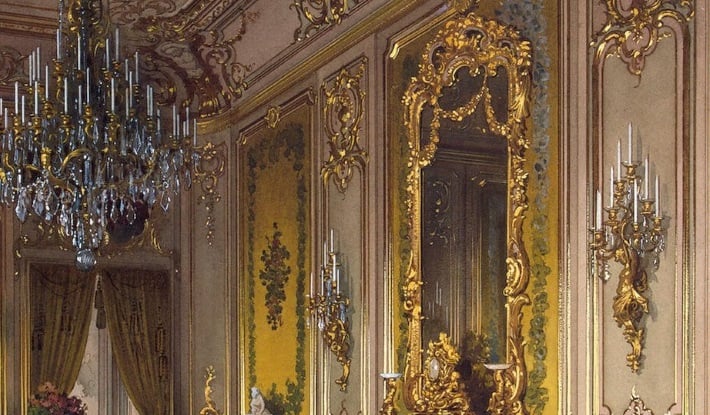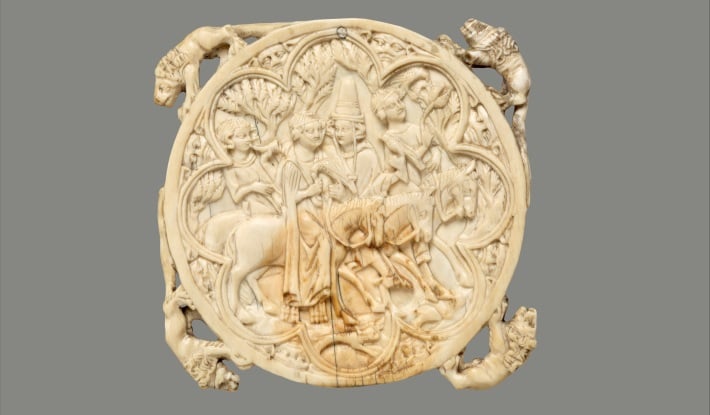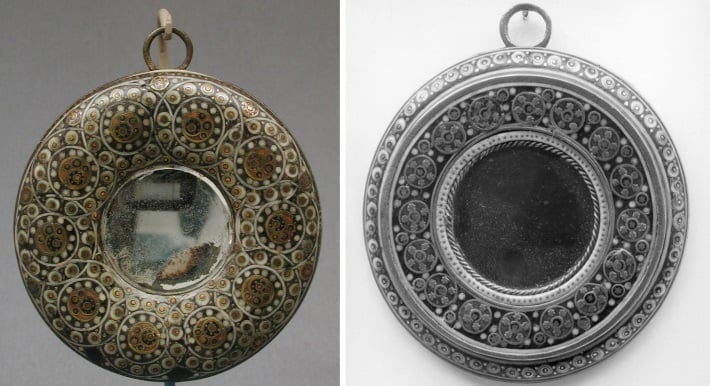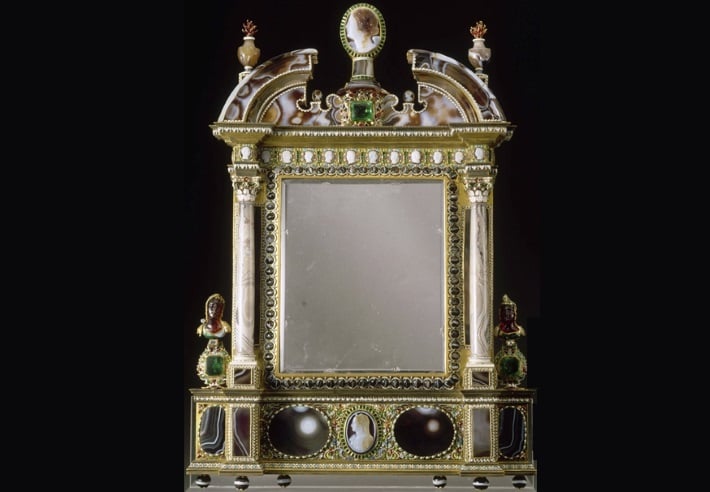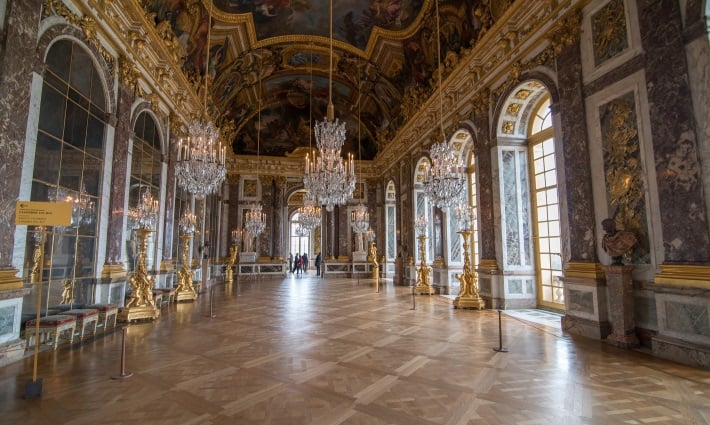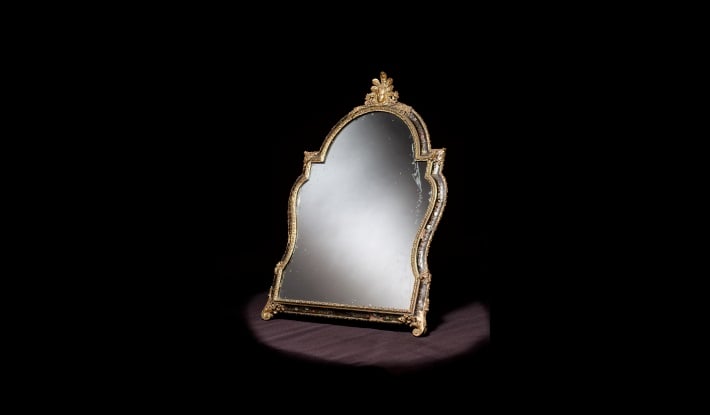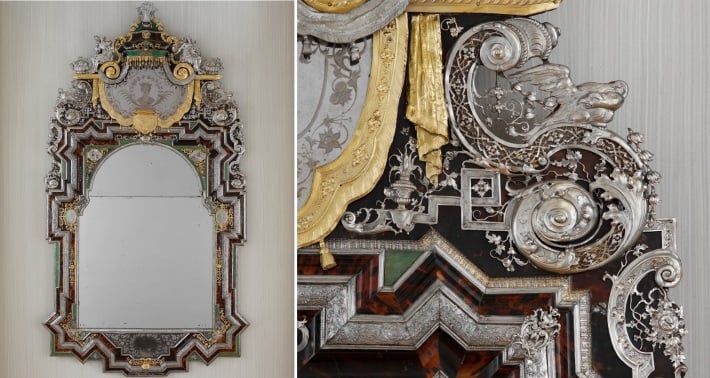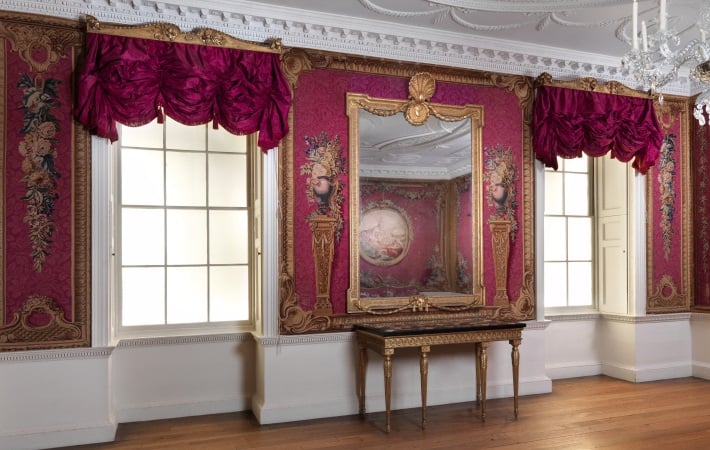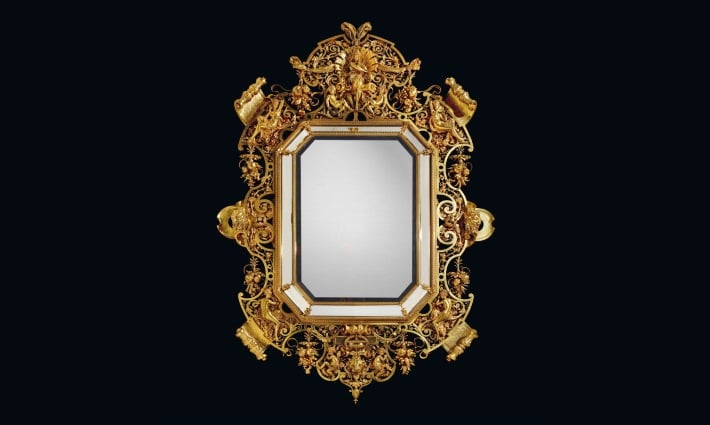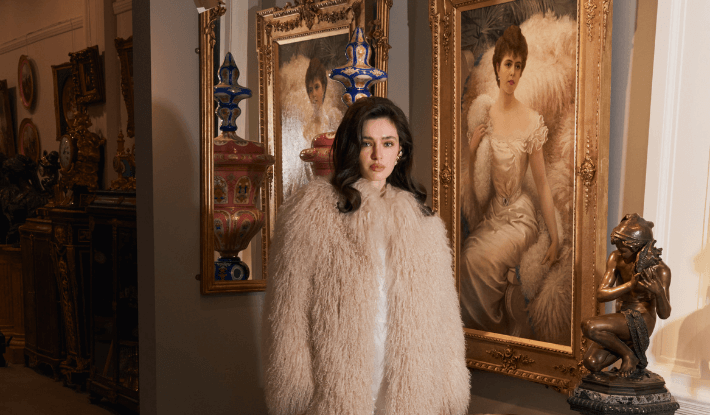The myth of Narcissus is perhaps the oldest and most enduring tale of the power of mirrors. The story of the young beauty doomed forever to stare admiringly at his own reflection is one we often tell as a cautionary tale, a lesson about the dangers of vanity.
But the mirror’s long association with the deadly vice of narcissism hasn’t stopped us designing ever more elaborate and opulent ways to see ourselves. On the contrary: for centuries, mirrors were among the most expensive and desirable objects on the market.
Here we offer a brief history of the mirror, told through eight antiques. These eight antique mirrors, many of them extraordinary feats of craftsmanship, have been chosen to illustrate the fascinating development of the art of mirror-making over the last 700 years or so.
Medieval ivory hand mirror, 14th Century
The medieval carved ivory hand mirror, currently on display at the Met Museum, New York
We start in the middle of the 14th Century, with this incredible handheld mirror. Measuring only 11cm by 10cm, this small object was the medieval version of today’s compact mirror.
Mirrors in the Middle Ages were enormously expensive, and the possession of even a small mirror in a case as intricately and elaborately carved as this would have been a clear display of wealth.
The case is beautifully carved from elephant ivory, which would have had to have been shipped all the way from Africa, not an easy undertaking in this era.
It depicts a scene of courtship, with a man and a lady hunting with falcons, and four lions carved around its exterior. The workmanship is superb.
What’s perhaps most striking about the piece, however, is that when opened it wouldn’t have contained a piece of mirrored glass like we might expect from a compact, but most likely a flat, polished piece of metal such as copper or tin. The original mirror for this particular case has been lost to time.
Metal mirrors such as these had been in existence from around 4000 BC, as glassmaking was not yet advanced enough to form the flat, even shapes needed to make glass mirrors.
Even still, metal mirrors would have been reasonably rare and difficult to afford, which is why they would have been placed in such beautiful, elaborately-worked cases.
Venetian glass mirror, 16th Century
Two similar Venetian glass hand mirrors, both dating from the 16th Century
It wasn’t until the 15th and 16th Centuries that the modern method of mirror-making was developed by craftsmen on the Venetian island of Murano, then the prime luxury glassmaking centre in the world.
Until the Venetian craftsmen perfected the art of mirror-making, there was no reliable way of getting glass to remain flat, clear and evenly thick. Ancient Roman glass mirrors, for example, were tinted green because of the iron present in the mixture.
The best most glassmakers in the Middle Ages could do was blow a large circular glass bubble and cut off a single, convex-shaped piece. This would mean that mirror images would be distorted (like looking at yourself in the back of a spoon). It’s not difficult to see why mirrors at this time were often associated with nightmares and the devil.
When the Venetian glassmakers started to develop methods for making flat glass mirrors with silver backings (as most mirrors are today), they immediately found themselves in high demand.
These two 16th Century mirrors, both part of the collection of the Met Museum in New York, are early examples of these new-style Venetian mirrors.
Although they are, by our standards, tiny – measuring only 7cm in diameter each – they were almost certainly extraordinarily expensive. Affordable mirrors were therefore small, but highly coveted nonetheless.
The intricacy of the decoration on the frames, featuring rich ivory and metal inlays, marks these small mirrors out as objects of high status. These would have been the forerunners to the magnificent Venetian mirrors of the 18th and 19th Centuries.
Rock crystal and gemstone mirror, late 17th Century
Louis XIV's rock crystal and semi-precious stone mirror, on display at the Louvre Museum in France. © 2001 RMN / Jean-Gilles Berizzi
While Venetian glass mirrors were catching on in Europe, craftsmen from elsewhere on the continent were still experimenting with alternative materials for mirrors.
This next piece, formerly owned by King Louis XIV of France himself, is perhaps the height of late-Renaissance opulence: a mirror composed entirely of precious and semi-precious stones.
Louis XIV was renowned for his extravagant tastes, and his magnificent collection of art and furniture: it’s probably not surprising that he should have owned one of the most spectacular and unusual mirrors of the day.
The mirror itself is made from rock crystal, a perfectly clear variety of quartz with a high reflectivity, and so would have been remarkably effective.
It is the frame of the piece, however, which is truly special, made from cut pieces of agate, rubies, diamonds, garnets, gold and enamel, and set with miniature cameos of the 12 Roman Emperors and the goddess Diana.
Louis XIV purchased the mirror in 1684, to form part of his exceptional collection of lapidary works. That such splendid materials and exceptional craftsmanship should have gone into making a mirror is evidence of quite how coveted mirrors were at the time.
This beautiful piece is the result of extravagant tastes meeting extravagant objects.
Hall of Mirrors, Versailles
The Galerie des Glaces at the Chateau de Versailles. © Jorge Lascar via Flickr
If Louis XIV’s love for elaborate, expensive mirrors wasn’t clear from the last object, then it will certainly be clear from this next – extremely famous – set of mirrors.
The Hall of Mirrors, or ‘Galerie des Glaces’, in the Palace of Versailles is one of the most iconic rooms perhaps in the world, and the central hall in the Palace of Versailles. Completed in 1684, it was Louis XIV’s great triumph in having the palace built.
It’s perhaps most famous in the modern era for being the room where the World War I Peace Treaty was signed, in 1919.
The Hall gets its name from the 17 monumental mirrored arches which line one wall of the gallery, opposite the 17 monumental window arches which line the other wall. By designing it like this, Louis XIV’s architects had hit on a new purpose for mirrors: the amplification of light within a space.
Because the mirrors directly reflected both the daylight coming from the windows opposite, and the light coming from the magnificent chandeliers in the room, the entire room would have been constantly filled with light.
Mirrors in the late 17th Century were still stratospherically expensive, and still the exclusive preserve of the Venetian glassmakers.
All of this changed with Versailles: Louis spent vast sums enticing workers from Venice to France to prepare the mirrors for the palace. The Venetians were allegedly so upset that they attempted to poison the men who deserted them.
The only technical difficulty which the mirror-makers encountered was the vast size of each one: due because of their production methods, it was almost impossible to make flat mirrors larger than about one metre square.
Their solution was to make each large mirrored arch out of individual smaller panels of mirror: there are an astonishing 357 mirror panels in total in the Hall of Mirrors.
Boulle marquetry toilet mirror, early 18th Century
The Regence period Boulle mirror, possibly attributed to BVRB I. © Bonhams
The Hall of Mirrors was unlike anything the world had seen before, in size and in scope, but this did not deter craftsmen from continuing to make smaller, more intricately-decorated mirrors and mirror frames.
This early 18th Century mirror, 78cm in height, has been designed to stand upright on a table, where it almost certainly would have been an object of display rather than a practical object.
The beautiful marquetry design on the back, the exquisite gilt bronze mounts, and the extravagant choice of materials – all of these ensure that this mirror is just as much high art as it is everyday object.
The mirror has been given a possible attribution of Bernard I van Risamburgh, the father of Bernard II, one of the leading ébénistes working in the early 18th Century, and one of the pre-eminent names in the development of the French Rococo.
Its design, however, belongs to an even more famous craftsman working at the same time: Andre-Charles Boulle. The back of the mirror features his distinctive brass and tortoiseshell marquetry inlay, in the form of birds and figures, as well as other inlays in mother-of-pearl, ivory and horn.
Boulle first published the design for this mirror in a book of drawings between 1708 and 1720; and there is a very similar mirror, attributed to Boulle himself, in the Wallace Collection.
This mirror was later acquired, at the beginning of the 19th Century, by the English Duke of Hamilton, an avid collector of Boulle furniture and decorative pieces.
German silver and silver-gilt mirror, c. 1710
Johan Valentin Gevers's silver, silver-gilt and tortoiseshell mirror, together with a detail from the top corner of the frame. Note the stunning intricacy of the metalwork here
The late 17th and early 18th Century European Baroque, the so-called ‘Age of Opulence’ that produced monumental palaces like Versailles and propelled cabinet-makers like Andre-Charles Boulle to fame did not, however, only take root in France and England.
Our next mirror is a southern German masterpiece of metalworking in luxurious materials, including silver, silver-gilt, tortoiseshell and green-stained ivory. It was made in the celebrated metalworking centre of Augsburg in Germany.
The mirror’s frame is uniquely and wonderfully colourful, thanks to the inlays of tortoiseshell and stained ivory; and the silver mounts at each of the corners are beautifully intricate. The mirror is truly the height of the early 18th Century silversmiths’ craft.
And whoever had commissioned this mirror had clearly spared no expense on its production, not least since the mirror stands at an extraordinary two metres in height.
It is thought that this mirror originally formed part of a pair, designed by the Augsburg silversmith Johann Valentin Gevers, given that it features medallions with allegorical depictions of two of the four continents (Europe and Asia), and two of the four Cardinal Virtues (Temperance and Prudence).
The other two of each four (Africa and America; Fortitude and Justice), it is thought, would be found on the other mirror, which has unfortunately now been lost.
Still, this mirror is a magnificent piece on its own, and is a wonderful reminder of what the early 18th Century silversmith could achieve.
Scottish George III period Chinoiserie style giltwood mirror, c. 1760-61
William Mathie's Rococo style mirror for the Earl of Wemyss. © 2017 Christie’s Images Limited
We now move further on into the 18th Century, with this exceptional giltwood mirror produced at the height of the English Rococo.
It hangs at two and a half metres in height, and was first produced for the 7th Earl of Wemyss by the Scottish cabinetmaker William Mathie.
The shape and frame of the piece is delightfully exuberant: curved all the way around its edges and decorated with delightful, naturally-inspired giltwood rocaille ornamentation.
The unusual shape of the mirror also means that the mirror panels have had to be carefully, and intricately, molded and cut.
Giltwood mirrors were becoming increasingly popular among aristocratic households in the 18th Century, and the intricacy of the wood carving, together with the quality of the gilding, mark this mirror out as one of the finest examples.
The most intriguing features of the mirror frame are the finely-detailed monkey and bird figures which adorn its sides. These exotic features are the clearest indication that this is a chinoiserie piece, designed for a chinoise room.
At the time this mirror was made, England was at the height of its chinoiserie craze. Nearly every major maker in the country, including legendary artisans like Thomas Chippendale, was designing furniture inspired by China.
It’s likely that this mirror would have been the centre piece in a room which also contained chinoisierie furniture, rugs, panelling and ornaments.
Robert Adam Neoclassical giltwood mirror, c. 1760
The large Neoclassical mirror designed by Robert Adam, now on display at the Met Museum in New York
At around the same time as makers like William Mathie were making exceptional Rococo style giltwood mirrors, Neoclassicism in England was beginning to take root.
This next mirror comes from a design by the pioneer of the Neoclassical style in England, Robert Adam. Scottish Architect Adam was responsible for designing some of England’s finest Neoclassical palaces, and furnishing them with his own designs.
This mirror therefore reflects the growing preference among Europe’s elite for large Neoclassical style houses which were fully decorated and furnished, and organised around a single design concept.
The mirror is simple and elegant, with restrained proportions and excellent symmetry, and is decorated with beautifully-carved Neoclassical ornaments: a ram’s head, a shell, and laurel garlands.
This mirror is not a showy piece, but it would have had a wonderful effect on the lighting and décor in a room. Though the design was originally Adam’s, this particular mirror was completed by the English furniture makers John Mayhew and William Ince, both active in the 18th Century.
What’s perhaps most astonishing about the mirror is that the entire 2.5 metres by 1 metre area is made up of a single mirror panel.
This would have been an extraordinary – and extraordinarily expensive – undertaking in the day, but demonstrates quite how far the craft of mirror-glass making had come since its early days.
Monumental Gilt Bronze Mirror by Barbedienne and Carrier-Belleuse, c. 1860
The 'monumental mirror' made by Carrier-Belleuse and Barbedienne for the 1878 Exposition Universelle. © 2014 Christie’s Images Limited
We’re saving the best until last with this mesmerising late 19th Century mirror, the work of the famed Maison Barbedienne in collaboration with master sculptor Albert-Ernest Carrier-Belleuse.
The 19th Century was known for its revivals: of the Renaissance styles, of the Rococo, of Neoclassicism. But here, in this mirror, we have something completely innovative, forward-looking and unafraid to embrace the new industrial technologies of the day.
There are two known versions of this mirror, one of which is in the Musée d’Orsay and the other selling at Christie’s in 2014 for a record-breaking £218,500. Both were produced for Barbedienne’s stand at the 1878 Paris Exposition Universelle.
The mirror is a monumental two metres in height, and the frame was modelled by the sculptor Carrier-Belleuse before being cast by the Barbedienne foundry.
Carrier-Belleuse was one of the most prolific sculptors of the late 19th Century and was famous both for being Auguste Rodin’s master, as well as for being the artistic director of the Sevres porcelain manufactory.
Carrier-Belleuse’s modelling was inspired both by the fabled silversmiths of late 17th Century Paris and Augsburg, and by the paintings of the French Renaissance. The frame features exceptional scrolling ornamentation featuring a nude Venus, putti, nymphs, Classical masks, fruit and shells.
He was probably assisted in the casting by Constant Sévin, the chief ornamentiste at Barbedienne. This kind of collaboration between three of the finest makers in France at the time (Carrier-Belleuse, Sévin, and Barbedienne) was not unusual for the Second Empire period, and was one of the reasons why France at that time was the major producer of luxury decorative arts.
Both sculptors were given an unusual amount of financial freedom in designing and creating this mirror, which is one reason why the frame is made from an exceptionally fine bronze, with exceptionally fine gilding.
It was thanks to the new industrial techniques of the day, especially gold-plating, that this mirror was able to be so flawlessly made and finished. This is a mirror very much of its time, a true monument to the 19th Century quest for perfection.




